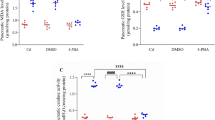Abstract
Endoplasmic reticulum stress (ERS) plays an important role in diabetes mellitus (DM), but the association between DM and ERS is unknown. We have previously shown that streptozotocin (STZ)-induced diabetes in rats is characterized by increased levels of ERS markers. Here, we tested whether the chemical chaperone 4-phenylbutyric acid (4-PBA) ameliorated ERS-associated apoptosis in pancreatic β-cells in rats with STZ-induced diabetes. Male Sprague–Dawley rats were divided into 3 groups: control group, DM group, and DM model plus 4-PBA treatment group (4-PBA group). DM model rats were induced by injection of STZ (60 mg/kg) intraperitoneally, and 4-PBA was administered daily by gavage at a dose of 500 mg/kg body weight for 20 days. β-cell apoptosis was higher in the DM group than in the control group. Moreover, the expression of caspase-3, Bax, and the ERS indicators Bip and CHOP was markedly elevated in the pancreas of rats in the DM group, whereas the expression of Bcl-2 was lower in these rats (P < 0.05). Blood glucose concentration in diabetic rats gradually decreased with 4-PBA treatment but remained higher at the end of the experiment compared to the concentration in control rats. Consistent with this, 4-PBA raised the fasting insulin level in diabetic rats; it also suppressed the expression of caspase-3, Bax, and ERS indicators but enhanced the expression of Bcl-2. In conclusion, 4-PBA protects pancreatic β-cells from apoptosis in STZ-induced diabetes by attenuating the severity of ERS.




Similar content being viewed by others
Abbreviations
- ERS:
-
Endoplasmic reticulum stress
- H&E:
-
Hematoxylin & eosin
- 4-PBA:
-
4-phenylbutyric acid
- RT-PCR:
-
Reverse transcription-polymerase chain reaction
- STZ:
-
Streptozotocin
- T1DM:
-
Type 1 diabetes mellitus
- TUNEL:
-
Terminal deoxynucleotidyl transferase biotin-dUTP nick-end labeling
References
J. Su, L. Zhou, X. Kong et al., Endoplasmic reticulum is at the crossroads of autophagy, inflammation, and apoptosis signaling pathways and participates in the pathogenesis of diabetes mellitus. J. Diabetes Res. 2013, 193461 (2013). doi:10.1155/2013/193461
R.G. Mirmira, Saturated free fatty acids: islet β cell “stressERs”. Endocrine 42, 1–2 (2012). doi:10.1007/s12020-012-9713-0
M.S. Hwang, W.K. Baek, Glucosamine induces autophagic cell death through the stimulation of ER stress in human glioma cancer cells. Biochem. Biophys. Res. Commun. 399, 111–116 (2010). doi:10.1016/j.bbrc.2010.07.050
S.E. Choi, Y.J. Lee, H.J. Jang et al., A chemical chaperone 4-PBA ameliorates palmitate-induced inhibition of glucose-stimulated insulin secretion (GSIS). Arch. Biochem. Biophys. 475, 109–114 (2008). doi:10.1016/j.abb.2008.04.015
T. Szkudelski, The mechanism of alloxan and streptozotocin action in B cells of the rat pancreas. Physiol. Res. 50, 537–546 (2001)
S. Roy, S.K. Metya, S. Sannigrahi, F. Ahmed et al., Treatment with ferulic acid to rats with streptozotocin-induced diabetes: effects on oxidative stress, pro-inflammatory cytokines, and apoptosis in the pancreatic β cell. Endocrine 44, 369–379 (2013). doi:10.1007/s12020-012-9868-8
N. Lin, H. Chen, H. Zhang et al., Mitochondrial reactive oxygen species (ROS) inhibition ameliorates palmitate-induced INS-1 beta cell death. Endocrine 42, 107–117 (2012). doi:10.1007/s12020-012-9633-z
I. Marhfour, X.M. Lopez, D. Lefkaditis et al., Expression of endoplasmic reticulum stress markers in the islets of patients with type 1 diabetes. Diabetologia 55, 2417–2420 (2012). doi:10.1007/s00125-012-2604-3
K.L. Lipson, S.G. Fonseca, F. Urano, Endoplasmic reticulum stress-induced apoptosis and autoimmunity in diabetes. Curr. Mol. Med. 6, 71–77 (2006)
A.K. Cardozo, F. Ortis, J. Storling et al., Cytokines downregulate the sarcoendoplasmic reticulum pump Ca2+ATPase 2b and deplete endoplasmic reticulum Ca2 +, leading to induction of endoplasmic reticulum stress in pancreatic β-cells. Diabetes 54, 452–461 (2005)
W. Sun, Y. Bi, H. Liang et al., Inhibition of obesity-induced hepatic ER stress by early insulin therapy in obese diabetic rats. Endocrine 39, 235–241 (2011). doi:10.1007/s12020-010-9429-y
N. Sato, F. Urano, L.J. Yoon et al., Upregulation of BiP and CHOP by the unfolded-protein response is independent of presenilin expression. Nat. Cell Biol. 25, 863–870 (2000)
N.L. Vanderford, Defining the regulation of IL-1β and CHOP-mediated β-cell apoptosis. Islets 2, 334–336 (2010)
S.A. Tersey, Y. Nishiki, A.T. Templin et al., Islet β-cell endoplasmic reticulum stress precedes the onset of type 1 diabetes in the non-obese diabetic mouse model. Diabetes 61, 818–827 (2012). doi:10.2337/db11-1293
M. Vilatoba, C. Eckstein, G. Bilbao et al., Sodium 4-phenylbutyrate protects against liver ischemia reperfusion injury by inhibition of endoplasmic reticulum-stress mediated apoptosis. Surgery 138, 342–351 (2005)
N. Sawada, J. Yao, N. Hiramatsu et al., Involvement of hypoxia-triggered endoplasmic reticulum stress in outlet obstruction-induced apoptosis in the urinary bladder. Lab. Invest. 88, 553–563 (2008). doi:10.1038/labinvest.2008.21
Z.F. Luo, B. Feng, J. Mu et al., Effects of 4-phenylbutyric acid on the process and development of diabetic nephropathy induced in rats by streptozotocin: regulation of endoplasmic reticulum stress-oxidative activation. Toxicol. Appl. Pharmacol. 246, 49–57 (2010). doi:10.1016/j.taap.2010.04.005
W. Qi, J. Mu, Z.F. Luo et al., Attenuation of diabetic nephropathy in diabetes rats induced by streptozotocin by regulating the endoplasmic reticulum stress inflammatory response. Metabolism 60, 594–603 (2011). doi:10.1016/j.metabol.2010.07.021
U. Ozcan, E. Yilmaz, L. Ozcan et al., Chemical chaperones reduce ER stress and restore glucose homeostasis in a mouse model of type 2 diabetes. Science 313, 1137–1140 (2006)
Acknowledgments
This work was supported by the Science Foundation of Jiangsu Educational Committee of China (No. 07KJD320144).
Conflict of interest
All authors declare that there are no conflicts of interest.
Author information
Authors and Affiliations
Corresponding author
Rights and permissions
About this article
Cite this article
Zhu, M., Guo, M., Fei, L. et al. 4-Phenylbutyric acid attenuates endoplasmic reticulum stress-mediated pancreatic β-cell apoptosis in rats with streptozotocin-induced diabetes. Endocrine 47, 129–137 (2014). https://doi.org/10.1007/s12020-013-0132-7
Received:
Accepted:
Published:
Issue Date:
DOI: https://doi.org/10.1007/s12020-013-0132-7




